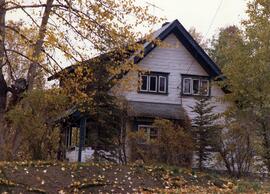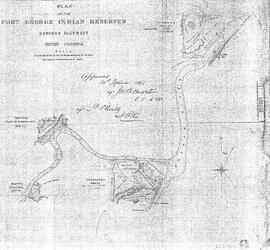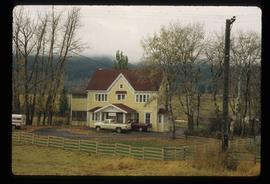The item is a photograph depicting a white heritage house in old South Fort George. It was known as the Moran house and was located at 3067 Queensway, Prince George. Annotation on the reverse side of the photograph states, "S. Ft Geo burned, demolished."
File consists of notes, clippings, and reproductions relating to 3067 Queensway, Prince George. The Queensway home was built in 1910 by Harry Close and Charlie Brown who operated a general store in South Fort George. It was purchased by a man named McLaughlin who was a wealthy lumberman, and later sold to Bert Roddis a government agent. The house had many occupants, but was next passed to Pat Moran in 1965 who continued to occupy the house into the late 1970s. Pat Moran owned Moran's Trailers in Prince George. Includes: "Queensway home built in 1910 by bachelors" clipped article from the Prince George Citizen (8 Dec. 1977); Also includes a photograph depicting a house on Queensway, Prince George and printed photographs depicting the house after a fire in 1998.
The item is a photograph reproduction print from the Fraser-Fort George Museum. Annotation on back: "P982.56.20 Close + Brown's Store. A.G. Hamilton's store was purchased by Harry Close + Charles Brown of New York City."
The item is a reproduction of a map originally surveyed in 1984 by F. A. Deveraux. The map is a plan of the "Fort George Indian Reserves" in the Cariboo District. Annotations include the approved signatures of Leo. B. Martin and R. O'Reilly dated 21 September 1895.
File consists of notes, clippings, and reproductions relating to Goat River trail. Includes: "Hike the historic Goat River Trail" pamphlet produced by Fraser Headwaters Alliance (2001).
File consists of notes and reproductions relating to Penny. Also includes photographs depicting various areas of Penny (2004).
File consists of notes, clippings, and reproductions relating to various communities along the East Line. Includes material regarding Penny; the Robson Valley; the Ancient Rainforest; Dome Creek; Bend; Loos; Crescent Spur; and Dewey. File includes photographs depicting the Fraser River and Morkill Forest Service Road near Crescent Spur and Dome Creek (2010).
File consists of notes, clippings, and reproductions relating to Mcbride and Dunster. Includes photographs depicting the Croyden cemetery and the Dunster ferry site (2005).
File consists of notes, clippings, and reproductions relating to Tete Jaune.
File consists of notes, clippings, and reproductions relating to Valemount. Also includes a photograph depicting the Valemount autowrecker (2005).
File consists of notes, clippings, and reproductions relating to Mount Robson and the Red Pass. Also includes photographs reproduced in 1982 depicting the Mount Robson Ranch (date of original photographs unknown).
File consists of notes and clippings relating to Jasper and the Yellowhead Pass.
File consists of a duotang containing a typed document entitled "John Giscome's Country" by Bruce Ramsey originally from 1964, but retyped by the Prince George Citizen newspaper.
File consists of handwritten notes by Kent Sedgwick relating to pack saddling to Tete Jaune Cache in 1962. Also includes a photograph depicting Cecil Giscombe in Penny (May 2004).
File consists of clippings, notes, and reproductions relating to the surrender of the original Lheidli T'enneh reserve and its cemetery, and the subsequent reserve relocation. Includes "Indian cemetery Fort George Park" typescript document by Kent Sedgwick for the Heritage Advisory Committee, which includes photocopies of original documents for the sale of the Indian reserve to the Grand Trunk Pacific Railway (23 Mar. 1983) and "Plan of the Fort George Indian Reserves" map depicting the locations of the reserves in and around Prince George. File also includes photocopies and reproduced photographs of the Prince George Indian Reserves from the Royal BC Museum and Archives.
File consists of notes, clippings, and reproductions relating to general Prince George history and heritage. Includes material regarding the Lheidli T'enneh People; Fort George; heritage houses in Prince George; buildings designed by architect Henry Wilson (Sacred Heart Church, Knox United Church, and City Hall); Fort George origins; the three Georges (South Fort George, Fort George, and Prince George); and other historic sites of Prince George.
File consists of notes, clippings, and reproductions relating to Chilako River and Indian Reserve No. 4. File contains material regarding the discovery of Indigenous artifacts in an archaeological dig by faculty and students from the University of Northern British Columbia; the establishment of a fur trading fort at Chala-oo-chick for the Hudson's Bay Company; and Indian Reserve No. 4 of the Lheidli T'enneh. Includes photographs depicting Fernie Ollinger's barn on Chilako Station Road and Chilako River (2006).
The item is one audiocassette containing a copy of an interview with Janet Kozak regarding the Lheidli T'enneh cemetery. Annotations on the case state, "Janet Kozak re: native cemetery 20 Apr/2010 COPY".
The item is one audiocassette containing an interview with Janet Kozak regarding the Lheidli T'enneh cemetery. Annotations on the case state, "Janet Kozak re: native cemetery side A only - 22 min 20 Apr/2010 - original".
File primarily consists of material regarding the Lheidli T'enneh Cemetery and the 1914 Royal Commission on Indian Affairs report on Prince George in relation to the "Fort George Tribe" and their lands and cemetery. Includes: photocopies from BC Archives of the Royal Commission transcripts; a report entitled "Archival Research Project - Fort George Park, up to 1998" prepared by Sites N Sounds Consulting for the Fraser-Fort George Regional Museum (1998); "Archaeological Impact Assessment, Fraser-Fort George Regional Museum, Lot 2, District Lots 343 and 417, Plan 32450, Cariboo District, City of Prince George, Permit 1998-218" prepared by Sites N Sounds Consulting (1998); "Indian Cemetery Fort George Park Prince George" typescript document by Kent Sedgwick for the Heritage Advisory Committee (23 Mar. 1983); a photocopied "Indian Cemetery in Fort George Park" plan drawn by the City of Prince George Public Works Department (Dec. 1978); and burial records for the Lheidli T'enneh Cemetery from the City of Prince George Cemetery System.
File consists of notes, clippings, and reproductions relating to the Lheidli T'enneh cemetery. Includes various printed emails between Bob Campbell of the Exploration Place and Kent Sedgwick (Jan. 2010) and two audiocassettes of an interview with Janet Kozak conducted by Kent Sedgwick (20 Apr. 2010).
Subseries consists of materials collected by Kent Sedgwick for research relating to Lheidli T'enneh First Nations. The Lheidli T'enneh are a sub-group of the Dakelh people whose traditional territory includes the city of Prince George, British Columbia. These files primarily consist of material regarding the original Lheidli T'enneh reserve and cemetery, the reserve relocation, and the desecration of the cemetery.
File contains slides depicting Cottonwood Island in Prince George, B.C. These photographs were taken by Kent Sedgwick when he was an instructor in Geography at the College of New Caledonia. The images were taken in support of a proposal by the New Caledonia Institute of Environmental Studies to create a municipal park at Cottonwood Island.
File contains slides depicting Island Cache on Cottonwood Island in Prince George, B.C. These photographs were taken in April 1970 by students involved in a Geography class at the College of New Caledonia. They record the community of Island Cache before the major flood in the spring of 1972.
These slides were utilised by CNC Geography Class taught by Alistair McVey before the 1972 flood and by Kent Sedgwick after the 1972 flood. Kent Sedgwick retained the original slides, except for two aerial views of the flooded area in the spring of 1972, which were from the in the City Planning Division files.
Image depicts the Onward Ranch near Williams Lake, B.C.
In a special article written by Barry Sale for The Williams Lake Tribune, he provides a detailed history of this ranch (see https://www.wltribune.com/community/haphazard-history-onward-ranch-steeped-in-history-5549882):
"One of the most famous ranches in the Cariboo region is the venerable and storied Onward Ranch. Located in the picturesque San Jose River valley, some eight miles southwest of Williams Lake, the land was first pre-empted in 1867 by Charles Boromeo Eagle. He had been born in Pennsylvania in 1837, coming from German (often called Pennsylvania Dutch) extraction. Eagle made his way to the Cariboo just as the placer gold rush was beginning to decline, and he decided to homestead in the fertile river alley. He built a small rough cabin on the north bank of the San Jose and began clearing land.
To finance his dreams, Eagle did day work for Pascal Bates, the owner of the 150 Mile Roadhouse and ranch. After work, Eagle would walk the five miles back to his little log dwelling and labour until dark to develop his own place. He invested the money he earned in livestock, seed plants, tools, and a small sawmill powered by water from the river. Slowly, he accumulated sufficient lumber to build a few outbuildings, including a small store. He gradually gained the trust of the local Indigenous people and built up a respectable fur trade. Eagle named his ranch the Onward after the region in Pennsylvania where his family had settled.
In the late 1860s, Charles met Annie Tatkwa, a Shuswap woman from the Bonaparte Band near Cache Creek. Prior to his arrival in the area, she had been a “country wife” to Thomas “Jack” Paxton, who had come out from England to seek his fortune. They had one son, Thomas Jr. (Tom). Paxton did not find the riches he sought and returned home with no plans to return to Canada, so, after a brief courtship, Annie and Charles were legally married at St. Joseph’s Mission, and Tom was adopted.
Over a span of almost 20 years, Annie gave birth to 10 children at the Onward. Four of them, all girls, died early in childhood. The six surviving children were Josh, Basil, William, Louise, Christine, and Rose. Annie, only 40 years old, died in September of 1887. She never recovered from the difficult childbirth of her youngest daughter, Ida May, who lived only for another five months following Annie’s passing. Charles never remarried.
The Onward was well situated on the route to the goldfields from Dog Creek, Alkali Lake, and Springhouse. It became a stopping place for packers, freighters, and travelers and it was an ideal place for a general store. At one time, in the mid 1890s, there were plans to build a town, to be named San Jose, right next to the Onward Ranch. Lots of 66 by 125 feet were advertised in the B.C. Mining Journal, published at Ashcroft for this “promising town in the South Cariboo, the centre of an extensive farming district and the natural distributing point for Alkali Lake, Chilcotin, Williams Lake Valley, Quesnelle Forks and Horsefly.” These lots were described as “beautifully located at the junction of the Williams Lake Road with the Cariboo Trunk Road, commanding an extensive view of the most picturesque part of Williams Lake Valley,” and “abundantly supplied with pure water from the San Jose River.” Apparently the “terms reasonable” weren’t, and there was very little interest.
In 1886, Charles began building a large new house from lumber he had milled on site. All the boards were planed by hand, sturdy timbers cut, and shakes split. The house was 2 and a half storeys in height and had verandas on two levels. Inside, it was meticulously furnished with oiled and polished pine. It cost approximately $10,000 to build, quite a sum in those days. The original log cabin was repurposed as a chicken house.
The ranch prospered. It was irrigated by a seven-mile long ditch with plentiful water year round. Over 110 tons of grain, 125 tons of vegetables, and 200 tons of hay were produced annually. A larger store was built, and contracts were signed to supply the mines and communities of the goldfields to the northeast with provisions, general merchandise, farm produce, beef and pork.
Charles Eagle died in 1890 at the age of 53. The ranch was taken over by his son John and adopted son Tom. Together, they formed the firm of “Eagle and Paxton, Store Merchants.” Unfortunately, they were not very well versed nor interested in the business of ranching, and they focused their efforts on the general store. For a while, they did very well, but as the mines in the goldfields began closing down, their business fell off. By 1900, both the store and the ranch were on the verge of bankruptcy, and in 1903, the entire operation was sold for $9,500 to John Edgar Moore, a pioneer rancher and businessman from Alkali Lake.
Over the next 17 years, Moore refurbished the ranch house, restocked the store and made it profitable again, added a huge livestock and storage barn (in 1911), and built up the farming and ranching operation. In 1920, nearing the age of 70, Moore sold the Onward to Charles Cowan for the price of $20,000. Cowan owned two ranches in the Kamloops area and was an agent for the Cariboo Trading Co., which owned the 134 Mile and the 150 Mile ranches. He and his wife Vivien moved into the big house, and Charles immediately concentrated on rejuvenating the land. He planted legume crops and plowed them under, fertilized, and brought water to arid areas. He also built miles of fences along with his new ditches, and within a few years, the place was producing excellent quantities of crops and livestock once again.
Charles and Vivien had two daughters, Sonia, born in 1919, and Drusilla (Dru), born in 1928. In 1929, the Cowans purchased the neighbouring 150 Mile Ranch. However, Charles’ health had begun to deteriorate, and the family spent more and more time in Victoria, where he received specialized medical care. During the family’s absence, John Zirnhelt took over the management of both ranches. In 1939, Charles died in Victoria as a result of a massive stroke.
Vivien and her daughters returned to the Onward to continue running the ranch. She was shocked to learn that her husband had left unsettled debts which amounted to about $9,500. The only way to pay them off was to make both ranching operations profitable.
That she did, with the help of her daughters, but she also found time to pursue her talent for painting. Her home became a gathering place for many artists, musicians, and writers. A.Y. Jackson, one of the famous Canadian “Group of Seven” was a regular visitor. In 1945, Vivien founded the Cariboo Art Society, which met frequently in the living room of the big ranch house. Both daughters were also artistically inclined, with Sonia becoming known throughout Canada for her paintings of the Cariboo, and Dru becoming a celebrated playwright and author. In the 1950s. Sonia and her husband Hugh Cornwall took over the management of the ranch, which now had a solid reputation as a centre for the arts.
The 150 Mile Ranch was sold in 1950, and in 1966, the Onward was sold off, this time to the Order of Mary Immaculate, the Catholic Oblate order which also owned the nearby St. Joseph’s Mission Ranch. The Oblates kept the ranch operating on a reduced scale, and they used the ranch house as a retreat for the priests and brothers. In 1979, St. Joseph’s Mission was officially closed down by the Roman Catholic church, and in 1980, the Onward was sold again. Since then, it has seen a number of owners, subdivisions, and changes. It is now owned by Tyrone Johnston, who is working diligently to bring back production and sustainability. After more than a century and a half of continuous operation, the Onward is indeed a special place with a unique and colourful history."
Image depicts the St. Joseph's Residential School in Williams Lake, B.C.
According to the National Centre for Truth and Reconciliation Archives (https://archives.nctr.ca/Cariboo-Residential-School) :
"Cariboo (Williams Lake) Indian Residential School (IRS) was located southwest of Williams Lake on highway #97 approximately halfway between Quesnel and Kamloops in the BC interior. The IRS operated from 1891 - 1981 (90 years) and closed on June 30, 1981.
Other names identifying the residential school include Williams Lake Industrial School and St. Joseph’s Industrial School from 1891 - 1920; Cariboo Industrial School and Cariboo Indian Industrial School from 1920 - 1927; Cariboo Residential School and Cariboo Indian Residential School from 1923 - 1981; St. Joseph’s Mission School (1929 - 1981), St. Joseph’s Indian Residential School (1932 and 1935), and St. Joseph’s Residential School (1963 and 1969); Cariboo Student Residence and Cariboo Indian Student Residence from 1967 - 1981. The school was also frequently referred to as the Indian School at 150 Mile House because of its location.
The Government of Canada was responsible for funding the school, which was managed and operated by the Roman Catholic Church from July 1891 - March 31, 1969. From April 1, 1969 - June 1981, the federal government managed and operated the IRS. In 1962, an agreement was signed between Her Majesty the Queen in Right of Canada represented by the Minister of Citizenship and Immigration and Indianescom (Oblate Indian and Eskimo Commission) for the management and operation of the Cariboo IRS.
No information regarding which grades were taught at the IRS exists.
Students were from the following bands: Alexandria, Alexis Creek, Alkali Lake, Anaham, Anderson Lake, Ashcroft, Bonaparte, Bridge River, Canim Lake, Canoe Creek, Clinton, Coldwater, Cowichan, Dog Creek, Euchinico, Fountain, High Bar, Kamloops, Kluskus Lake (Kluxkux Lake), Kuklinko, Lake Babine, Lillooet, Little Shuswap, Moricetown, Mount Currie, Natzoo, Nazko, Nemiah Valley, North Thompson, Pavillion, Pemberton, Quesnel, Redstone, Riske Creek, Seton Lake, Skwah, Soda Creek, Squamish, Stone (Stoney), Taodistan, Toosey, Ulkatcho (Ulgatcho), and Williams Lake. "was opened was opened by Roman Catholic missionaries in 1891. In 1902 nine boys ran away from the school, one of them dying of exposure. In 1920, nine boys ate poisonous water hemlock in what parents believed to be a response to discipline at the school. One of these boys died. The school closed in 1981. In the 1980s and 1990s two former staff members pled guilty to charges of sexually abusing students in the 1950s and 1960s. In 1998, a former principal apologized to a former student and school employee who had charged him with a series of sex offences. "
Image depicts the interior of Rupert Square Mall in Prince Rupert, B.C.
The item is a photograph depicting foliage on the street corner across 1414 Ash Street, Prince George, BC.
The item is a photograph depicting the Red Rock school circa. 2001.
The photograph depicts an airplane hangar at the Prince George airport. The sign on the building reads, "nt air." A white building and beige building are shown at a distance in front of the hangar.
The photograph depicts two buildings, one beige, the other white, at the Prince George airport.
The photograph depicts three buildings, white, beige, and blue at the Prince George airport. Annotations on the photograph describe the buildings as, "RCMP, airport terminal building, [and] small arms building."
The photograph depicts three buildings, white, beige, and blue at the Prince George airport.
The photograph depicts a two-story white house at 7295 Cummings Road outside of Prince George. Annotation on reverse side of photograph states, "7295 Cummings Rd, relocated 1976."
The photograph depicts a blurred image of a yellow carpet with colourful designs.
The photograph depicts a blurred image of a yellow carpet with colourful designs.
The photograph depicts a white duplex on Marston Road. The addresses on the duplex read 4603 and 4633. A blue Chevrolet truck is parked next to the building.
The photograph depicts a white duplex on Marston Road. The address on the duplex reads 4555.
The photograph depicts a white duplex on Marston Road. The addresses on the duplex read 4603 and 4633. A blue Chevrolet truck is parked next to the building.
The photograph depicts an airplane hangar at the Prince George airport. The sign on the hangar states, "nt air."
The photograph depicts a white workshop with a red roof at the Prince George airport.
The photograph depicts a white house in the Old Cariboo Highway area outside of Prince George, BC. An RV is parked next to the house and a horse can be seen in a fenced off area behind the house.
The photograph depicts a duplex on the lot located at 4084 Old Cariboo Highway outside of Prince George, BC. The house is white stucco with a sheet metal roof. The duplex on the right side has Halloween decorations on the door and in the window.
The photograph depicts a duplex on the lot located at 4084 Old Cariboo Highway outside of Prince George, BC. The house is white stucco with a sheet metal roof.
The photograph depicts a duplex on the lot located at 4084 Old Cariboo Highway outside of Prince George, BC. The house is white stucco with a sheet metal roof.
The photograph depicts a two-story white house at 4486 Zilkie Rd. Prince George. Annotation on reverse side of photograph states, "Zilkie Rd."
The item is a photograph depicting the interior of a silo at the Salmon Valley Ranch. The silo is in disrepair and there are many holes in the ceiling.
The item is a photograph depicting the interior of a silo at the Salmon Valley Ranch. The silo is in disrepair and there are many holes in the ceiling.
The item is a photograph depicting a silo at the Salmon Valley Ranch.
File consists of notes and reproductions relating to the Salmon Valley Ranch. Also includes photographs depicting the Salmon Valley Ranch.




